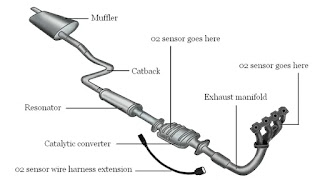Cooling systems:
This prevents the engine form overheating. It may be of air cooling or water cooling types, the former being more commonly used in smaller engine of two-wheelers, while the later types of cooling systems are predominantly used in engines of the rest of the automobiles.
This prevents the engine form overheating. It may be of air cooling or water cooling types, the former being more commonly used in smaller engine of two-wheelers, while the later types of cooling systems are predominantly used in engines of the rest of the automobiles.
Fuel system:
This includes storage tank for fuel, piping work for supply to the engine and arrangement for mixing with air and spraying into the engine cylinder.
Exhaust system:
Its function is to vent exhaust gases with least back pressure and also to reduce engine noise with the help of muffler. these days converters are also fitter in the exhaust pipe to reduce the harmful constituents in the exhaust gases.
Lubrication system:
This reduces friction to decrease wear of moving parts. Relatively less viscous lubricating oils are used in engine, whereas oils and greases are used in the transmission and wheel bearings.
Ignition system:
Its function is to supply high voltage surge at the desired instant and of adequate strength to produce a spark in the engine. Earlier electro-mechanical system were systems were used, which have given was to electronic systems in modem engines.
Electrical system:
It consists of a storage battery, charging system and stating system. The battery supplies electricity for starting the engine, providing energy for spark and for all the electrical devices in the vehicle, e.g., lighting, heating, visiting, music system, etc. The charging system consists mainly of an alternator and is used to continually change the battery to keep it charger at all times. The starting system consists motor and a device to disconnect the same from the engine as soon as the engine is started.







Nice bro 👍
ReplyDeletegood
ReplyDelete